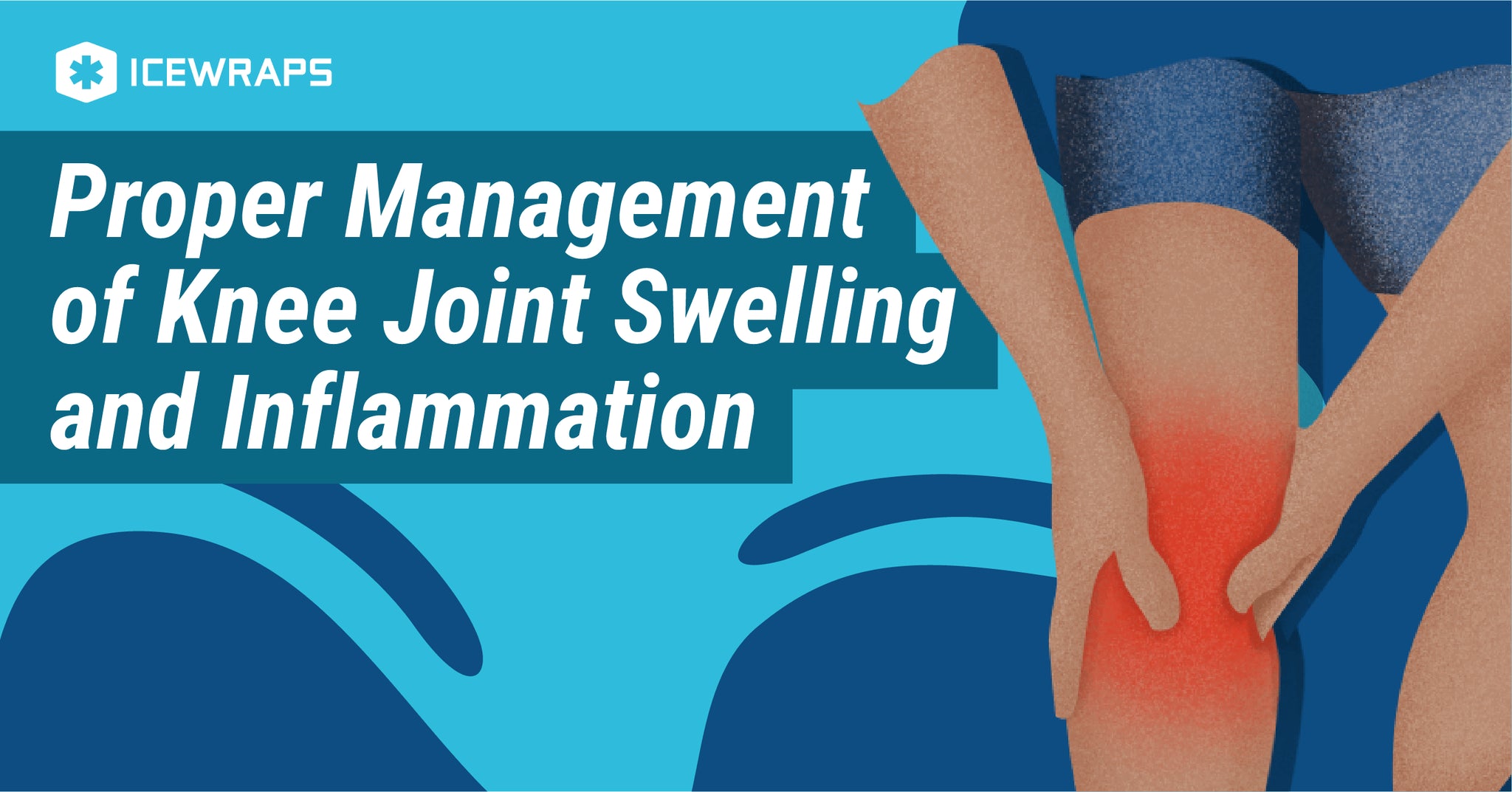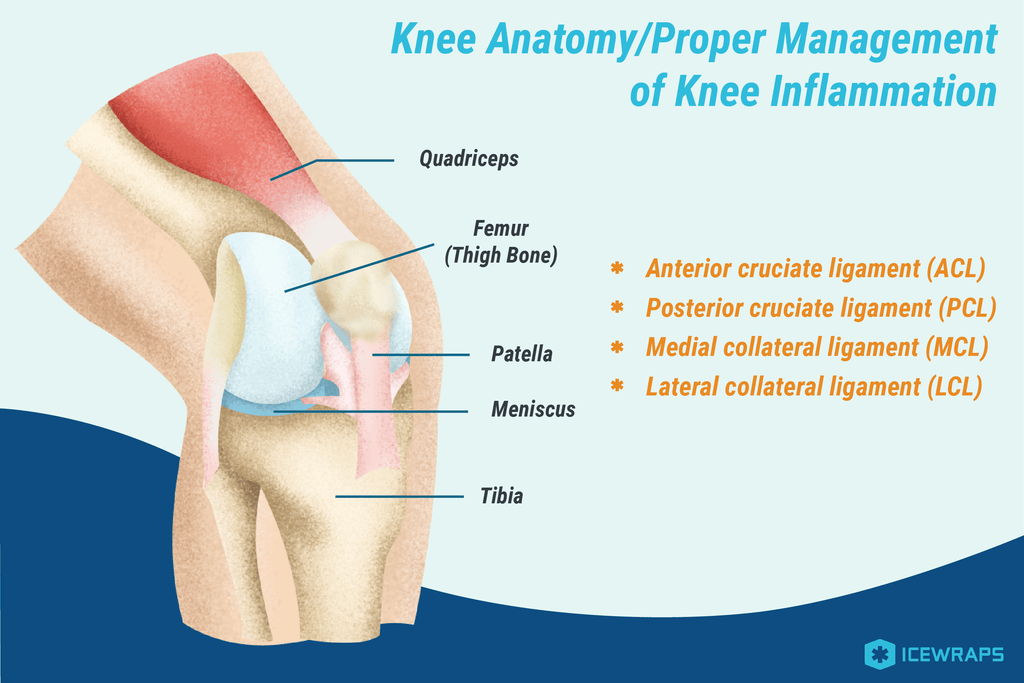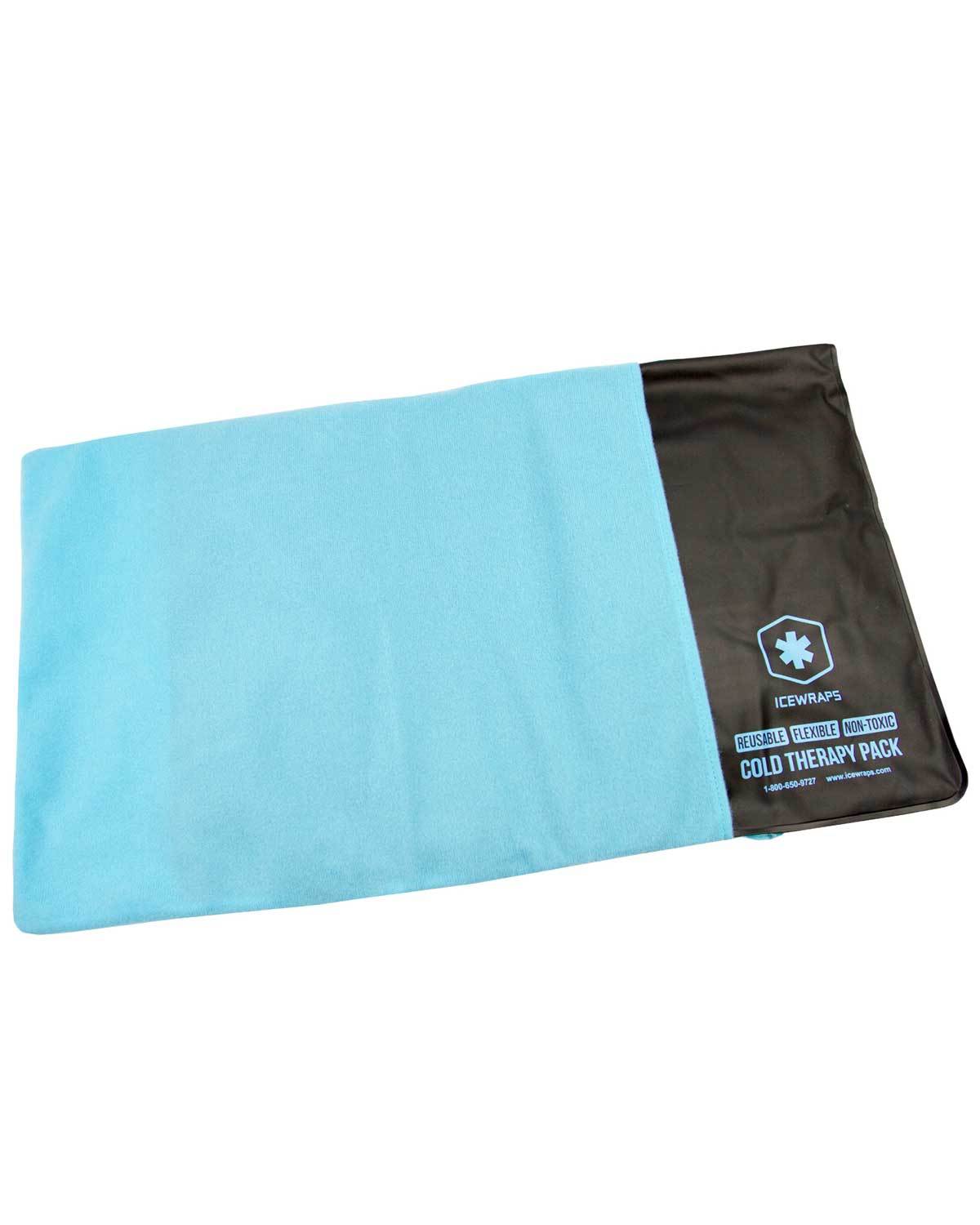Your Cart is Empty

Contents
If you have knee pain and swelling, then you understand how difficult it can be to manage. The swelling in your knee can limit your knee's range of motion, and it may prevent the muscles around your knee from functioning properly.
There are many different causes of knee swelling. Sometimes the cause is obvious, especially in cases of severe trauma. Other times, knee swelling can see to occur for no apparent reason. To fully understand pain and swelling in your knee, it is a good idea to understand the basic anatomy of the human knee joint.
Anatomy of the Knee
Your knee is a hinge type joint that is comprised of the articulation between your femur (the thigh bone) and your tibia (your shin bone). Another small bone called your patella, or knee cap, also is an important player in knee joint mechanics. These three bones all interact to form your knee joint.

Inside your knee there are four major ligaments that help hold your knee bones together. Ligaments are structures that connect one bone to another. The four ligaments of the knee include:
Your knee joint also contains two shock absorbers called the medial and lateral meniscus. These structures help to provide padding between the end of your femur and tibia. The ends of the three bones in your knee are lined with hyaline cartilage that helps the bones glide and slide past one another.
There are many different muscles that cross the knee joint and help to move it. The major muscles, such as the quadriceps and hamstrings, help to provide dynamic stability and motion to your knee. Smaller muscles around your knee also help to guide and support the joint.
A small fluid filled sac around your knee, called a bursa, help the muscles and tendons glide and slide normally near your knee. There is a bursa in the front of your knee over the patella, and one on the inner part of the shin that helps a muscular attachment called the pes anserine glide and slide normally.
Causes of Knee Swelling
With so many different structures surrounding the knee joint, both internally and externally, it stands to reason that there are many different causes of knee swelling. Any injury to the various structures in your knee may cause swelling. But sometimes, swelling in your knee persists long after the initial insult and injury have healed. This can make getting to the bottom of persistent knee swelling difficult.
Whenever a structure or structures are injured or damaged in your knee, inflammation may result. There are certain hallmarks of inflammation, including:
The inflammatory process is your body's natural way of healing injured tissues. But long term inflammation can be a real problem and a sign that your body is continually working to heal an injury. Mechanical stressors to the tissue over time may prevent appropriate healing from occurring, and long term inflammation may result leading to continual tissue swelling and pain.
If you are experiencing knee swelling or pain, it is a good idea to check in with your doctor. He or she will likely perform special diagnostic tests to check the status of the structures of your knee. These tests may include:
X-rays. A simple x-ray test allows your doctor to evaluate the bony anatomy of your knee. The x-ray picture helps your doctor rule out or rule in a fracture in any of the bones of your knee. The x-ray can also be used to evaluate the amount of space in your knee and to see if any of the joint surfaces are arthritic. The x-ray may not show the bones in great detail to rule out a micro-fracture or stress fracture in your knee, so your doctor may also order a CT scan if you are experiencing knee pain and swelling.
CT Scan. A CT scan, or computed tomography scan, is a special diagnostic test that involves using high powered x-rays to assess the bones in your knee. The picture obtained by a CT scan is typically in 3 dimensions, and it can be manipulated to assess the bones in your knee in greater detail than a simple x-ray can. The CT scan is often used to assess knee joint arthritis or a stress fracture in your knee.
MRI. A magnetic resonance imaging (MRI) study is a specialized diagnostic test that can give your doctor a detailed look at the soft tissue anatomy of your knee. An MRI of your knee will show your knee ligaments and menisci in great detail, and your doctor can assess the integrity of those structures when evaluating your knee pain and swelling. The knee MRI may also show the muscular attachments and bursa around your knee so your doctor can assess these structures as well.
Remember that no diagnostic test is perfect. Sometimes MRI, CT scans, or x-rays do not show every anatomical problem in your knee, or the tests may indicate that the structures in your knee are not injured. These diagnostic tests are very sensitive, but they may not be specific to your knee joint pain and swelling, and they only serve to rule in or out possibilities that may be causing your problem.
Injuries that May Cause Knee Swelling
Sometimes specific injuries or accidents may cause knee pain and swelling. Other times, your knee swelling and pain may seem to come on for no apparent reason. Common injuries and problems to the knee structures that may cause swelling may include the following:
Meniscus injuries: The medial and lateral meniscus are structures in your knee joint that provide shock absorption between your tibia and femur. These crescent shaped structures are made of cartilage, and they help your knee joint glide and slide normally.
Injuries to your meniscus are typically caused by a rapid and forceful twisting motion to your knee while your foot is planted on the ground. The twisting motion may place increased stress and strain through your knee meniscus, resulting in a tear. A tear in your meniscus may cause significant pain and swelling in your knee.
Sometimes, meniscal tears occur without significant trauma and result from wear and tear or repetitive strain to your knee joint. Arthritic changes in your knee may cause bony overgrowth around the joint and could lead to meniscus tears or irritation. This may cause knee swelling.
Knee arthritis: The hyaline cartilage lines your tibia, femur, and knee cap and allow those bones to glide and slide past one another as you bend and straighten your knee. Over time, this cartilage begins to wear down, and osteoarthritis sets in.
Since arthritis is an inflammatory condition, you will likely experience the signs of inflammation - tissue redness, pain and swelling. Your knee may also feel tight when it is swollen, and this may result in a loss of range of motion in your knee. As your knee arthritis progresses, this loss of motion may lead to decreased functional mobility. Therefore, managing the pain and swelling of knee arthritis is paramount to successfully treat the condition.
Knee ligament sprains: The major ligaments of your knee are responsible for controlling the forces that act upon the joint on a day to day basis. Any high velocity force to your knee may result in a sprain of one of the ligaments in the joint.
Ligament sprains are graded on a 3 tiered scale:
Knee bursitis: As stated, several small, fluid filled sacs called bursae (plural for bursa) are located around your knee joint. These structures help the tendons and muscles around your knee glide and slide properly over the bony prominences of your knee.
A forceful blow to your knee may result in inflammation to a bursa. Knee bursitis may result, and pain and swelling may be present in the area that is inflamed.
Bursitis of your knee may also occur from repetitive stress and strain to the muscles and tendons around your knee. If a muscle group is tight or weak, it may result in increase stress and strain over a bursa, and knee bursitis may result, causing swelling and pain around your knee.
Other soft tissue injuries in the knee: Other injuries to your knee may cause swelling to occur. Repetitive strain to the hamstring and quadriceps tendons or to the iliotibial band may cause localized soft tissue inflammation which results in swelling.
Knee surgery: If a knee injury is severe or if your knee arthritis progresses to the point where normal functional mobility is compromised, you may require knee surgery to correct the problem. After knee surgery, you can expect swelling to occur as the healing process progresses and your body works to heal the surgically repaired tissue. Controlling post-operative swelling is paramount after surgery to ensure a successful outcome.
Treatment of Knee Swelling
If you are experiencing swelling in your knee, you can, and should, take steps to manage the swelling. One method to manage knee swelling involves using the R.I.C.E. method. R.I.C.E. is an acronym for rest, ice, compression, and elevation. Whenever knee pain and swelling strikes, treating the problem with R.I.C.E is a safe action to take.
If you are experiencing knee swelling, your first step should be to rest. Taking pressure off the structures of your knee that are injured is recommended to allow those structures to heal properly.
Although rest is the first part of the R.I.C.E acronym, be careful not to completely immobilize your knee. Spending too much time with no knee motion may cause significant problems with your knee's mobility and function. A visit with your doctor or physical therapist can help you decide on the optimal resting and loading strategy for your knee after injury. In fact, some motion to your knee may help mechanically squeeze the surrounding tissues and control some swelling within the joint.
While resting your knee, it is recommended that you use ice to help control the swelling. The ice helps to cause vasoconstriction - a narrowing of the micro-capillaries around your knee. This helps to limit blood flow to your knee joint and the surrounding structures, helping to control the swelling.
Compression is also recommended to use while you ice. The compression helps to create a mechanical squeezing of the blood vessels and tissues around your knee joint, limiting the amount of blood flow and influx of blood and inflammatory cells. This helps to limit swelling and maximize your knee's range of motion after injury.
When choosing the right ice pack for your knee, there are many variables to consider. Ice wraps like the Elite Kold Knee Wrap may be prefect to provide all around icing to the joint and surrounding tissues. The easy to use Cold One Knee Ice Wrap helps to provide firm compression while icing, a combination that is recommended by many sports medicine professionals.
Once you have chosen the right ice pack for your knee swelling, remember to perform the final piece of the R.I.C.E. protocol - elevation. Elevating your knee while icing and compressing the joint helps to allow gravity to work to push fluid and inflammatory waste out of your knee's tissues and back into the venous return system in your body.
 |
|
ICEWRAPS 10X14 STANDARD COLD THERAPY CLAY PACK WITH COVER |
 |
What About Heat for Swelling?
It is recommended you use the R.I.C.E. protocol for acute knee swelling for 24 to 48 hours after injury. Some doctors and sports medicine professionals recommend switching to heat once the acute inflammatory phase is under control with ice and compression.
Heat helps to open up blood vessels, and this is thought to wash away inflammatory waste cells and bring in fresh oxygen and nutrients to your injured tissue. This can help improve joint mobility and can restore your knee's range of motion after injury.
Care should be used when utilizing heat for your knee swelling. Opening up blood vessels around the injured tissue may increase the amount of swelling in your knee joint and surrounding tissues. This may lead to a worsening of your condition.
When using heat wraps and packs, you should also take care not to burn your skin around your knee. Follow the instructions carefully on your heat pack, and use extra toweling if necessary between your skin and the hot pack to prevent burns and irritation.
Some knee wraps can be used both as an ice pack and a hot pack. The ActiveWrap Knee Hot/Cold Pack is one of the more versatile wraps available that can be used as ice for the initial acute inflammation, and then used as a heat pack when mobility and increased blood flow is needed.
Another combination heat and ice wrap is the PolyGel Thermoactive Knee Hot/Cold System. This professional grade ice and heat pack allows you to dial in customized compression with the patented hand pump, ensuring you have the right amount of support while using ice or heat on your knee.
The Role of Exercise in Managing Knee Swelling
Exercise is a physical stressor to your body. So why should you exercise a body part that is inflamed or injured? Won't that simply make things worse?
When you are dealing with knee joint swelling and pain, an appropriate exercise program and loading strategy can actually help manage the swelling. Exercise helps to squeeze on the muscles, tendons, and joint capsule of your knee. This squeezing effect can help to act like a sponge to move blood, inflammatory waste, and fluid out of your knee and into the venous return system.
Care must be taken when exercising your knee if it is swollen or inflamed. Too much exercise can cause mechanical overload to the tissues, leading to continued or worsening inflammation and swelling. A visit to your doctor or physical therapist is the safest way to learn the proper exercises to do to manage your knee pain and swelling.
Bottom Line
Any traumatic injury or repetitive stress and strain may cause localized knee tissue or joint swelling. This swelling can limit the way your knee bends and straightens, and it may create significant functional limitations in walking, running, or performing basic work and recreational activities.
Comments will be approved before showing up.